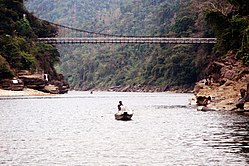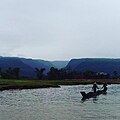| Piyain River | |
|---|---|
 | |
 | |
| Location | |
| Countries | India, Bangladesh |
| District | Sylhet |
| Physical characteristics | |
| Source | |
| • location | Umgat river of Assam |
| Mouth | |
• location | Surma River |
| Length | 145 kilometres (90 mi) |
Piyain River a trans-boundary river of India and Bangladesh. It is a tributary of the Surma river, which originates from the Umngot River in Meghalaya. The river enters Bangladesh through Sylhet district.
Contents
The Piyain River, once large and flowing, has been left mostly dry due to floods in the 1980s, unregulated stone quarrying, and illegal sand extraction. [1] [2]





